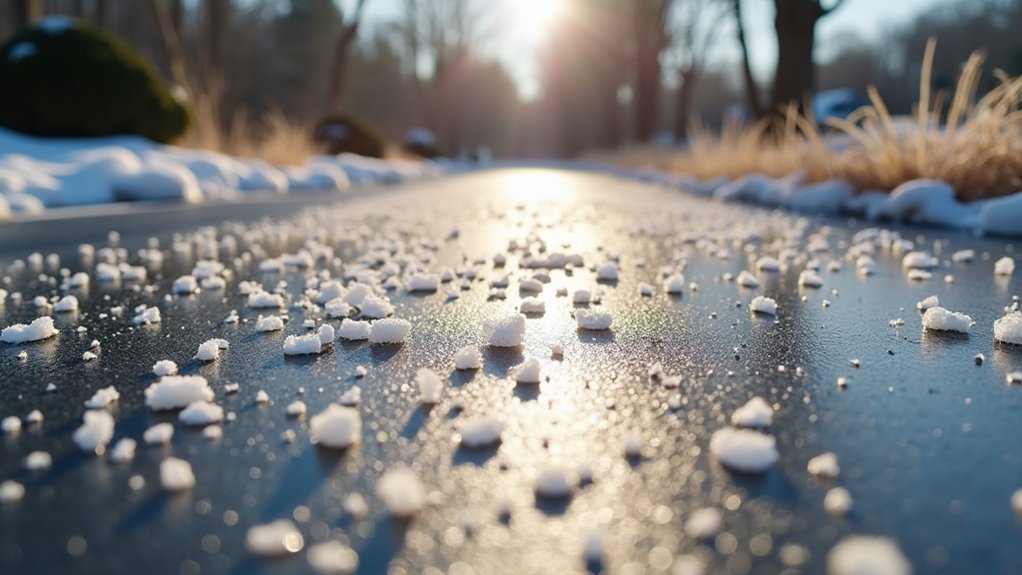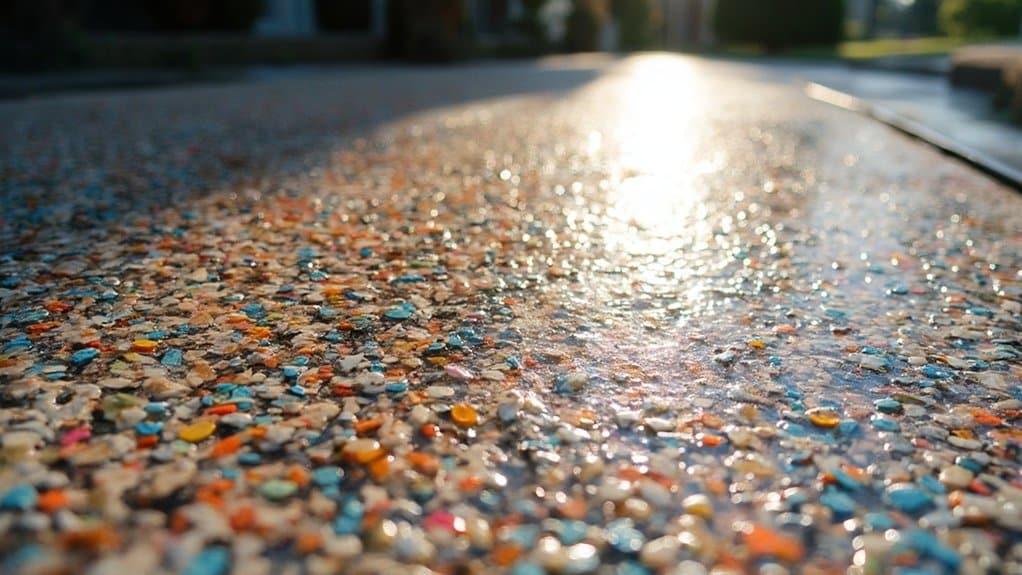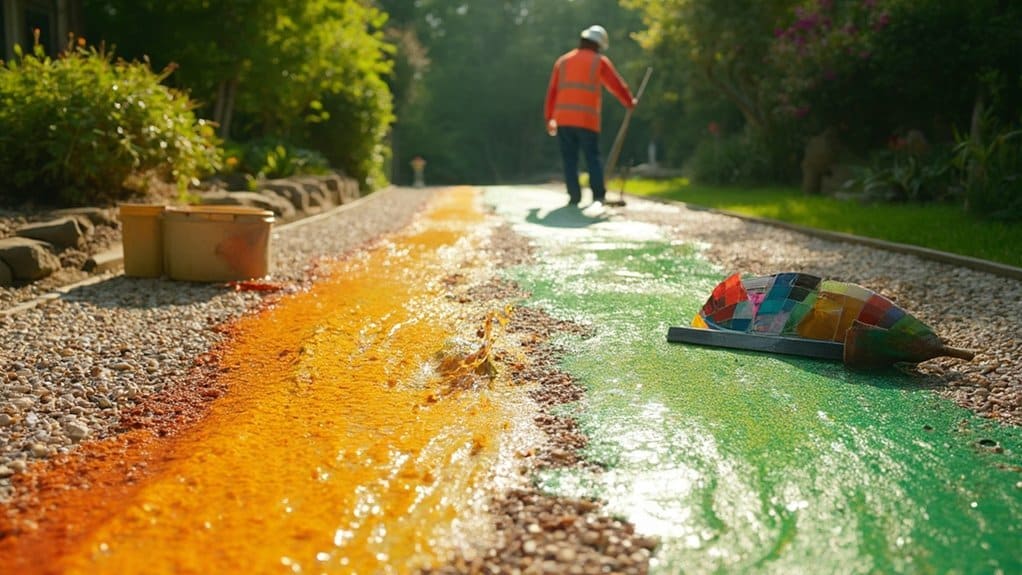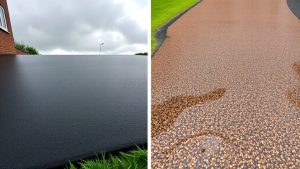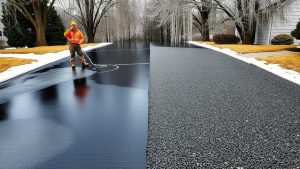Yes, you can use rock salt on a resin driveway to manage ice, but it’s essential to do so carefully. Rock salt helps to break the bond between ice and the surface, particularly if applied before snow falls. However, using too much can cause long-term issues like erosion and discolouration. After using rock salt, make sure to sweep away any residue. If you’re looking for more tips on maintenance and care, there are a few best practices to keep in mind.
Table of Contents
ToggleKey Takeaways
- Rock salt can be used on resin driveways to prevent ice and manage winter conditions effectively.
- It’s best to apply rock salt before snow falls to help break the bond between ice and the driveway surface.
- Limit the application to one cup of salt for every ten slabs or two parking spaces to avoid overuse.
- Remember to promptly remove any leftover salt to prevent long-term damage to the driveway.
- Consider using eco-friendly alternatives to rock salt to reduce environmental impact and maintenance costs.
Understanding Resin Driveways and Their Durability
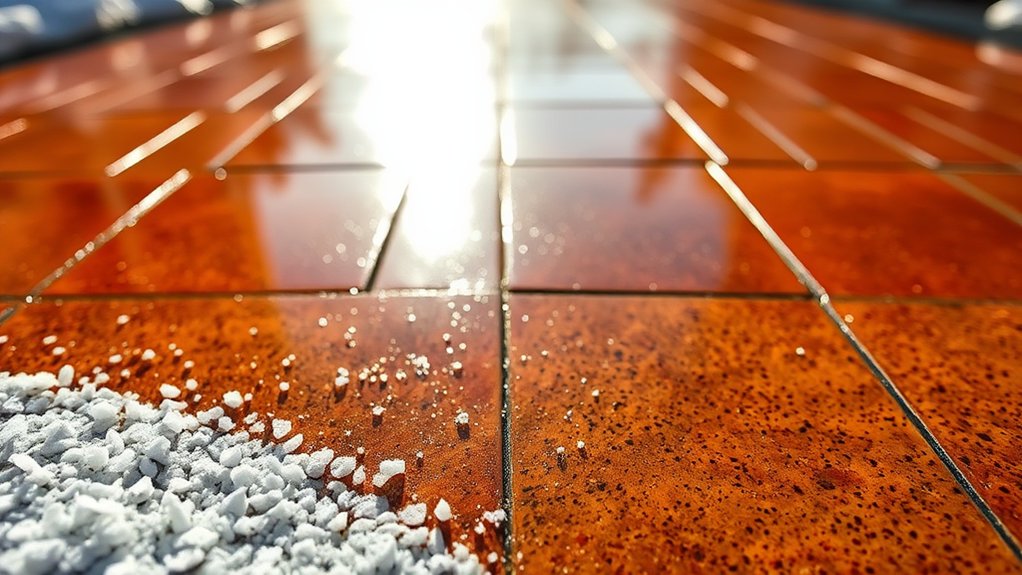
When choosing a driveway for your home, resin driveways are a strong option due to their impressive durability. One of the main benefits is their resistance to cracking, which helps keep your driveway intact even with heavy traffic.
With an expected lifespan of 15 to 25 years, they represent a worthwhile investment, especially if you use quality materials and ensure proper installation. Proper installation is critical for durability, as it can extend the lifespan up to 25 years.
To maximise their longevity, regular maintenance is crucial, as it can help you avoid costly repairs later on. Additionally, resin driveways are permeable, allowing water to drain through and reducing the likelihood of puddles and ice formation.
The Role of Rock Salt in Ice Management

Rock salt is vital for breaking the bond between ice and your resin driveway, making it easier to remove snow and ice.
To ensure safe use, it’s crucial to follow best practices that protect both your driveway and the environment. For instance, applying rock salt before snow falls can help prevent ice from forming. Understanding how to use rock salt effectively allows you to manage winter conditions without damaging your driveway. Additionally, using a salt-brine mixture can be a more environmentally friendly option for pre-storm anti-icing.
Effective Ice Bond Breaking
Ice management heavily depends on effective methods to break the bond between ice and surfaces, with rock salt being a key player. Its primary component, sodium chloride, disrupts the ice lattice through chemical reactions.
Here’s a straightforward breakdown:
- Dissolution: Rock salt dissolves in water, releasing sodium and chloride ions.
- Hydrogen Bond Disruption: These ions interfere with the hydrogen bonds in water, weakening the ice structure.
- Freezing Point Depression: Rock salt lowers the freezing point of water, enabling it to melt ice even below 0°C.
- Effectiveness Range: It works best between -6.7°C and -12.2°C, but becomes less effective as temperatures drop further. Furthermore, more ions from calcium chloride can hinder rigid ice bonds more effectively than sodium chloride.
Using rock salt effectively can significantly enhance your ice management efforts.
Safe Application Practices
Effective ice management for your resin driveway requires the right materials and safe application practices. To maximise the effectiveness of salt while preserving your driveway, limit the use of rock salt to around one cup for every ten slabs of pavement or two parking spaces.
Only apply salt when ice is present, and ensure it’s spread evenly to prevent concentrated areas that could damage the resin. After the ice has melted, promptly remove any leftover salt to avoid long-term harm.
Using plastic snow shovels instead of metal ones can help prevent surface scratches. It’s also wise to combine salt use with physical snow removal to minimise chemical reliance, keeping your driveway safe and intact. Additionally, regular maintenance is essential to maintain the appearance and longevity of the resin surface.
This balanced approach ensures your driveway remains both functional and visually appealing.
Comparing Rock Salt and Road Grit
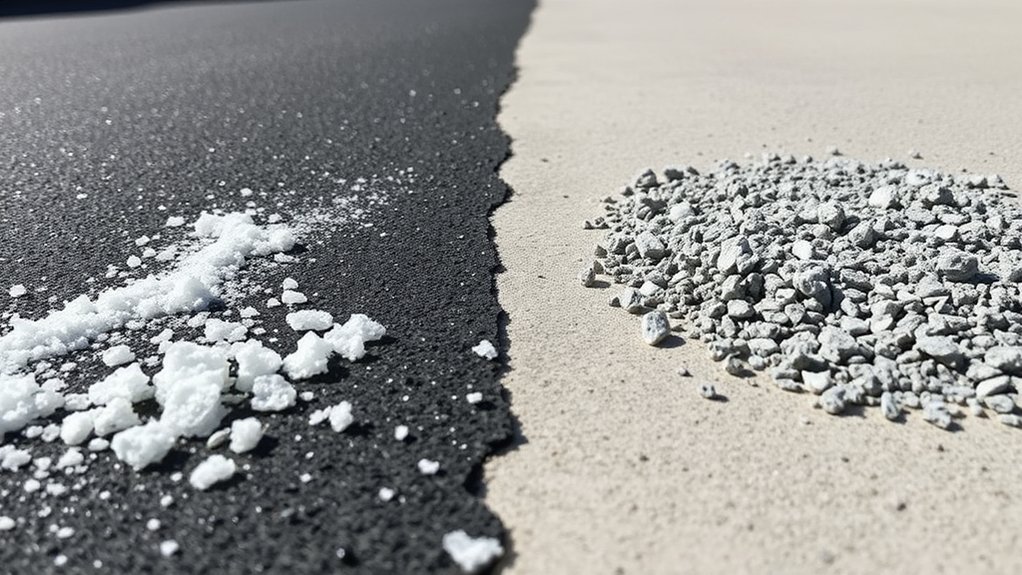
When choosing a de-icing solution for your driveway, you might be torn between rock salt and road grit. Here are some key differences to consider:
- Effectiveness: Rock salt is effective down to about -6°C (20°F), whereas road grit can perform better in lower temperatures thanks to added substances.
- Cost: Rock salt is typically more cost-effective for home use compared to road grit.
- Environmental Impact: Both can damage plants, but road grit often has less environmental impact due to its specially formulated mixtures.
- Application Scale: Rock salt is best suited for smaller areas like driveways and parking spaces, while road grit is intended for larger roadways.
Best Practices for Applying Rock Salt
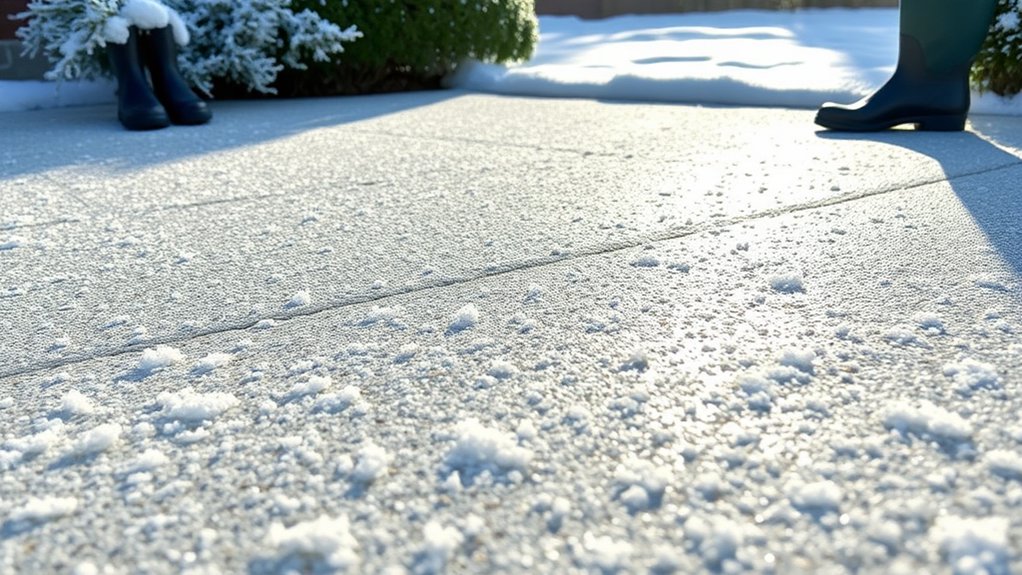
Choosing the right de-icing solution is just the first step; applying rock salt properly can significantly improve its effectiveness on your resin driveway.
First, ensure compatibility with your resin manufacturer. Clear away loose snow or slush for direct contact, and use a heavy-duty spreader to apply the rock salt evenly—avoid clumps. Use salt sparingly to prevent compromising the resin bonds.
Monitor temperatures and apply rock salt when they dip below freezing to stop ice from forming, ideally before it sets in. Reapply as needed after heavy snowfalls. Additionally, using UV-stable resin can help maintain the durability and appearance of your driveway when exposed to harsh winter conditions.
You might also consider alternatives like calcium or magnesium chloride, which pose less risk of damage to your driveway.
Finally, once temperatures rise above freezing, wash the area thoroughly to remove any salt residue, keeping your driveway in good shape.
Snow Removal Techniques for Resin Driveways

Removing snow from a resin driveway requires careful methods to protect its surface.
Here are some straightforward tips to ensure you keep your driveway safe while maintaining its appearance:
- Use plastic shovels: These will avoid scratching the resin.
- Choose sand or fine gravel: Both offer traction without causing damage.
- Utilise snow blowers with rubber blades: They’re gentle on the surface and help prevent abrasion.
- Clear snow promptly: This stops it from building up and reduces the risk of damage.
Regularly check your driveway and clean it before snow falls. Additionally, it is wise to apply moss removal products during the winter months to prevent any potential slipping hazards.
These simple steps will help you maintain a pristine resin driveway throughout winter.
Environmental Considerations of Using Rock Salt

While rock salt may seem like an effective option for clearing snow and ice in winter, its environmental impact is concerning.
Salt runoff can contaminate water sources, raising sodium and chloride levels that endanger aquatic life. This contamination may also affect drinking water, posing health risks for individuals with high blood pressure.
Additionally, rock salt can degrade soil quality, disrupting nutrient availability and harming plant life.
The effects on wildlife are significant, as salt can attract animals to roads, increasing the risk of collisions.
Moreover, the use of rock salt accelerates damage to roads and infrastructure, leading to expensive repairs.
Given these economic and environmental costs, considering alternative deicers like magnesium chloride could be beneficial.
Reducing the environmental impact of salt use is essential for promoting healthier ecosystems and minimising the need for costly remediation efforts.
Long-Term Maintenance and Care

To keep your resin driveway in excellent condition, it’s important to remove snow regularly during winter.
Ensure you follow the correct guidelines for salt application to manage ice effectively without damaging the surface.
Additionally, clean your driveway seasonally to eliminate any salt residue and preserve its appearance.
Regular Snow Removal
Keeping your resin driveway free from snow is crucial for maintenance and safety. Regular snow removal improves efficiency and prevents dangerous ice formation.
Here are four essential tips:
- Choose the Right Shovel: Use a plastic or non-metal shovel to avoid damaging the surface of your driveway.
- Clear Regularly: Shovel snow as soon as it settles to make it easier to manage and reduce the risk of accumulation.
- Inspect for Damage: Regularly check your driveway for any signs of wear or damage and address any issues promptly.
- Monitor Vegetation: Watch for plant growth in cracks, as this can weaken the surface.
Salt Application Guidelines
Proper salt application is crucial for preserving your resin driveway during winter.
Use white rock salt for melting ice, applying no more than one to one and a half cups per ten paving slabs or two parking spaces. This controlled use helps protect the resin binders.
Apply salt early and keep an eye on the weather to time your applications wisely, stopping once temperatures rise above freezing.
Avoid using road grit or sand, as these can clog the permeable surface.
After winter, give your driveway a thorough wash to remove any salt residues.
Seasonal Surface Cleaning
For the upkeep of your resin driveway, seasonal surface cleaning is crucial for its durability and appearance.
To ensure effective maintenance, follow these steps:
- Regular Sweeping: Remove leaves and debris, particularly in autumn, to prevent unsightly stains.
- Mild Detergents: Combine with warm water for cleaning, then rinse thoroughly.
- Pressure Washing: Use low pressure (below 150 bar) to avoid damaging the surface.
- Stain Removal: Treat oil stains with cat litter and rust stains with a mixture of lemon juice and salt.
Cost Implications of Using Rock Salt in Winter
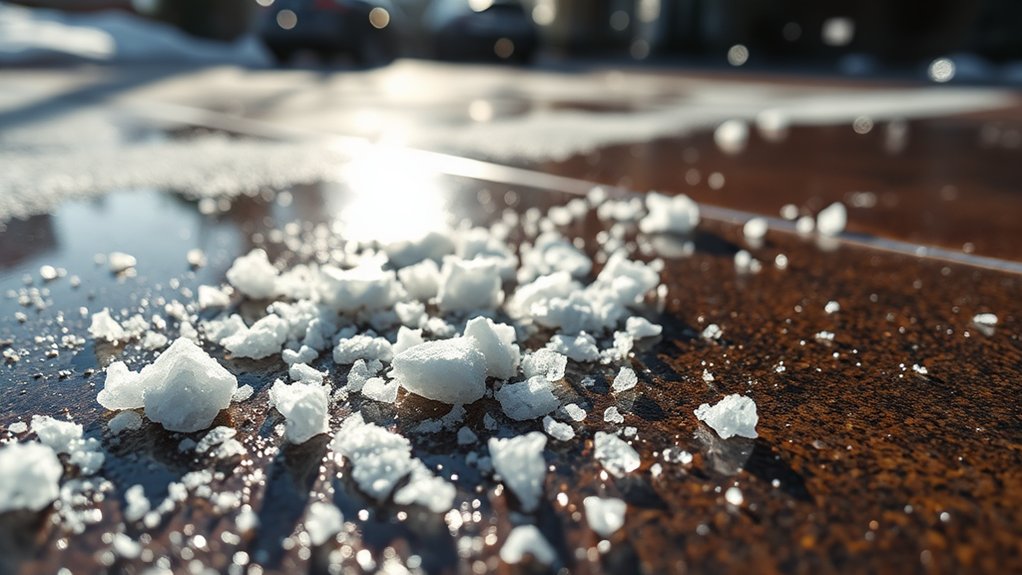
As winter approaches, it’s crucial to consider the cost implications of using rock salt on your resin driveway. While rock salt is effective for melting ice and improving traction, buying in bulk can offer significant savings.
However, be mindful of the potential long-term costs of driveway repairs and maintenance. Excessive use of rock salt can damage your resin surface, leading to erosion and discolouration, which can increase repair bills.
Moreover, the environmental impact of rock salt shouldn’t be ignored; it can harm local plants and waterways.
While eco-friendly alternatives may have a higher initial cost, they could save you money in the long run by minimising damage and reducing maintenance needs.
Frequently Asked Questions
Can Rock Salt Harm the Resin Driveway’s Appearance?
Yes, salt can damage the appearance of your resin driveway. To keep it looking its best, make sure to remove any salt residue promptly after use. Consider using alternative methods for managing ice, such as sand or grit, to help protect the surface in the long run.
How Often Should I Apply Rock Salt?
To maintain your driveway during winter, consider how often to use rock salt. Apply it when temperatures fall below freezing. Adjust the application based on conditions to ensure effective maintenance and safe traction. For instance, if snow is forecasted, spreading rock salt beforehand can prevent ice from forming.
Is Calcium Chloride Safe for Resin Driveways?
Calcium chloride is not safe for resin driveways as it can cause damage and discolouration. To maintain your resin driveway effectively during winter, opt for alternatives that won’t harm the surface. Always test any product on a small area before applying it more broadly.
What Are the Signs of Salt Damage on Vegetation?
Signs of salt damage on plants include yellowing leaves, reduced growth, and early leaf drop. To help plants recover, flush the soil with water and consider planting salt-tolerant species to prevent future issues.
Can I Use Metal Tools for Snow Removal?
Picture a gardener nurturing delicate blooms. When it comes to clearing snow, it’s best to use gentler tools for your driveway. Avoid metal shovels, as they can scratch and damage your resin surface. Instead, consider using plastic or rubber alternatives that won’t harm your driveway while effectively removing snow.
Conclusion
In summary, you can use rock salt on a resin driveway, but it’s important to be aware of its potential drawbacks. While salt can reduce ice formation by up to 70%, it may damage your driveway over time. To safeguard your investment, consider using alternatives like sand or eco-friendly de-icing products. Regular maintenance and quick snow clearance will also help maintain the integrity of your resin surface during winter.
Not sure how much a resin driveway will cost in 2025? Discover the key factors influencing pricing and installation that Read more
Wondering if you can lay a resin driveway over concrete or tarmac? Discover the essential tips for a successful installation Read more
Discover how to create a stunning DIY resin driveway with our step-by-step guide—your perfect outdoor upgrade awaits!

